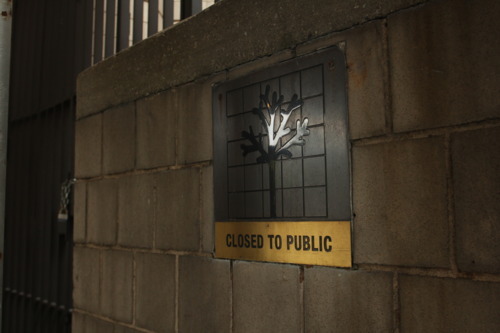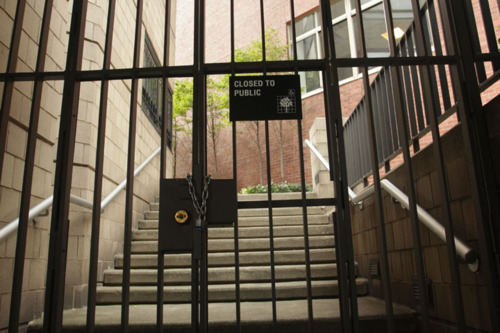The concrete stairwell hidden in the shadow of Dag Hammarskjold Tower, a 43-story condominium on the Upper East Side, is supposed to lead to an open plaza, a respite for the public from the crowded streets. In 1982, the high-rise’s developer struck a deal with the city to provide this space in exchange for erecting a tower one-third larger than zoning would usually permit.

But this “public” plaza remains private. Visitors are greeted by a locked gate and a city-issued plaque of a tree, widely used to identify parks, altered to say “closed to public.”
The shut-down plaza stands in contrast to the scene six miles downtown, where Occupy Wall Street demonstrators have massed for two weeks in Zuccotti Park – a small block of private land owned by Brookfield Properties, landlord of the office building next door. Last week, the owner posted signs forbidding tents, sleeping bags and other personal possessions at the park, rules that have been ignored by protesters. But Police Commissioner Ray Kelly has said officers will not bar protesters from using the space, and so far Brookfield has refrained from enforcing its restrictions.
New York City has more than 500 of these privately owned public spaces. A 2008 report by Manhattan Borough President Scott Stringer’s office and Community Board 6 surveyed 77 of those spaces in east Midtown and cited Dag Hammarskjold Tower as one of the worst violators of promises to keep private space public. Not much has improved here since then.
The conditions here are a far cry from the improvements envisioned in the 1961 ordinance that first allowed developers to build taller and bigger buildings in exchange for plazas, atriums and other open-air spaces accessible to the public.
Michael Keane, the lead author of the 2008 study, said his research began because Community Board 6 members were concerned these promises were not being met. At the time of the study, the district had the lowest amount of open space by acre of any neighborhood in Manhattan.
“There were issues over what was promised and what was delivered,” Keane said.
For eight months, Keane found that almost four in 10 of the properties were out of compliance with their open space pledges, and 11 of these had multiple violations. Some were not handicapped-accessible. Others had locked gates and “no trespassing” signs. One was filled with garbage from a nearby restaurant.
Keane said that while most spaces in the area were well maintained and used freely by the public, the violators specifically discouraged public access. “Developers were able to build bigger, taller buildings,” he said, “but then in turn reneged or with-held access to much of these parks or let them fall into disrepair.”

Since the report, some of the worst 11 spaces have improved – most notably a plaza on Third Avenue owned by Murray Hill Mews Owners Corp. Before, a nearby restaurant used the space as storage. Today, the area is lined with trees and benches, and a sign displays the park’s hours. But most others have stayed the same, and signs, barriers and other cues discourage people from entering.
The Department of Buildings is responsible for enforcing open-space commitments. But its records show just one violation on record for Dag Hammarskjold Tower – a 2000 citation for a failure to install promised bicycle racks in the plaza.









